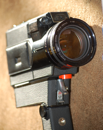Syllabus for Freshman Seminar 002-007: Making a Science Film
- composition
- close-ups
- continuity
- camera moves
- cutting
- Bacteria: Friend and Foe
- Powers of Ten
- Large Hadron Collider
- The Divided Brain
- Drew Berry: Animations of unseeable biology
- Gun Cotton (nitrocellulose) - Periodic Table of Videos
- Discover magazine award winning video: The Problem With Math
- Discover magazine award winning video: String Ducky
- The Cosmic Microwave Background
- The Rainforest
- Bill Nye Demonstrates Distance Between Planets
- LHC Rap
- Colliding Particles
- Grierson
- Errol Morris: A Brief History of Time
- Seven Rules for Making a (Science) Movie
- 22 Frames that always work
- Why equipment isn't everything
- Advice on interviewing
- Framing Shots
- adjusting audio for still images
- Open Source Movies
- Royalty Free Music
- Free Music for Educational Use
Location: Physics Rm. 432.
Time: Thu. 2:10-4:00 pmLecturer: John Terning
Office: 435
Web Page: /teaching/FRSFilm/
Email: jterning+FRS@gmail.com
Course Description:
This course will examine techniques for making movies that explain science to the general public. Students will make their own short movie. Students must provide their own access to a mini-DV or HD video camera and a Macintosh computer with iMovie installed. Students will become familiar with the techniques used in the past for explaining science through film and have practical knowledge of how to produce a short movie. The final movies will be posted on You-tube.
Objective:
The student will be able to produce and direct a short documentary film.
Format:
During the two hour, weekly meetings, we will review and discuss examples of science films and discuss film making techniques, including shooting video, sound recording, cinematography, lighting, animation, and editing. In addition to the two hour weekly meetings, students will produce their own 5-10 minute film in small groups. Grading: Students will be graded on: the quality of their participation in class discussion (25%), responses to reading asignments (5%), on a final project of producing a 5-10 minute film on some aspect of science of their own choice (40%), and for completion of interim milestones for keeping the project on schedule (30%).
Schedule:
You should come to the seminar prepared to discuss or (ask questions about) the current reading. At least one hour before class time you should send a "tweet" with a comment or question about the reading. You can send an additional "tweets" about something you want to discuss during the seminar. This will require that you sign up for a free Twitter account. Your "tweet" should contain the hashtag #scifilm.
My class tweets will be available at twitter.
Jan. 10: Introduction
Jan. 17: Videography, reading assignment: direction, research, and copyright
Jan. 24: Cinematography, reading assignment: treatment, camera moves and shooting sequences
The five C's of cinematography:
Jan. 31: Lighting, reading assignment: lighting and field production
Feb. 7: Sound Recording, reading assignment: interviewing, audio, sound, microphones
Feb. 14: Special Effects/Animation, reading assignment: scrolling credits, Quicktime effects, and talent release
Feb. 21: Editing, reading assignment: editing and fine tuning
Feb. 28: Sound Mixing, reading assignment: narration, fading audio, cutaway sound
Mar. 7: tweet about what you would like to discuss, or problems you are having in editing
Mar. 14: Screening
Project Milestone Schedule:
Jan. 17: submit idea via twitter (132 characters or less)
Jan. 24: submit research (point form, minimum 500 words, include sources and a list of four possible people to interview)
Jan. 31: submit treatment (minimum 800 words, see handout)
Feb. 7: submit shooting script (minimum 1000 words, or storyboard with approx 25 shots, see this sample)
Feb. 14: submit shooting schedule and locations and raw footage from an interview (approx 2 minute "tiny" .3gp file) in the Smartsite dropbox
Feb. 21: submit second raw footage (approx 2 minute "tiny" .3gp file) in the Smartsite dropbox
Feb. 28: submit editing script (log of all footage and ordered list of shots to be used)
Mar. 7: submit rough cut (5-10 minute "tiny" .3gp file) in the Smartsite dropbox
Mar. 13: submit final cut (5-10 minute "large" .mov file on CD or flash drive)
Grading:
Students will be graded on:
the quality of their participation in class discussion (25%),
responses to reading asignments, i.e tweets (5%),
meeting interim milestones on time (30%),
short documentary (40%).
The final film will be graded on:
Comprehensibility
Logic
Cinematography
Sound
Style
Films from 2013
Coffee
Dreams in a Psychological World
Lunacy
Over the Limit
The Science of Brewing
Additional Materials
The Meyer Media Lab at 1154 Meyer Hall has a room full of the Macs equipped with iMovie.
Other Information
If you have not already done so please review the UC Davis Code of Academic Conduct.
If you need to document a learning disability contact the Student Disability Center.
